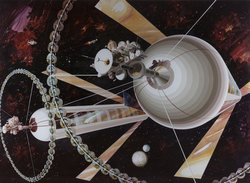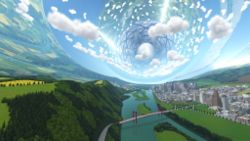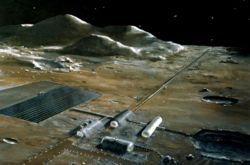| << Page in early stages >>
|
 Main Page > Colonising Space > Space habitats Main Page > Colonising Space > Space habitats
 A pair of O'Neill cylinder habitats  Inside a large landscaped cylindrical habitat (credit: Eric Bruneton) Space is a very harsh environment and it may be hard to imagine wanting to live in such a seemingly bleak place, but taming it is only a matter of some (admittedly fairly serious) engineering and is entirely within our current technical capability.
There are many challenges to enable building these towns and cities off-Earth. Two prominent ones are raw materials and gravity. A colony of any size will have to be self-sufficient in materials as it will not be practical to ship them up from the surface of the Earth due to the enormous energy required to climb against its pull. Escaping this pull long-term also causes major problems for the human body. Muscles get very weak, including the heart, and bones de-mineralise. The only real solution is to generate artificial gravity by rotation – even for Moon-bases if people are going to stay for any length of time.
There have been many studies over the past thirty years to understand what kind of habitats could be built and what size constraints there are based on current engineering knowledge. Surprisingly in the 1970s the answer was that using bridge and ship-building techniques it would possible to build cylindrical mega-structures up to 30 kilometres long and 6 kilometres in diameter, with a single one able to comfortably house several million people.
Being mega-scale engineering projects, it is not hard to see that similar techniques used in the habitat's construction could be used to make the interiors of these habitats be like beautiful places on Earth, such as rolling green English countryside. Some designs even have enough atmosphere inside them to make the sky appear blue.
Material
 Lunar mass driver which could be used to launch mined material from the moon into lunar orbit using solar power It would be far too inefficient to build these huge structures from material brought up from the surface of the Earth, so for orbiting colonies near Earth it has been proposed to use material mined from the moon or near-Earth objects  (particular asteroids and comets) and transported to where it needs to be using solar powered mass-drivers (particular asteroids and comets) and transported to where it needs to be using solar powered mass-drivers  . .
Life support
There have been several attempts on Earth to construct a closed ecological system  and we have learned a lot from these. If we can build a fully closed ecological system on Earth, there is no reason why we cannot do so in space. and we have learned a lot from these. If we can build a fully closed ecological system on Earth, there is no reason why we cannot do so in space.
Areca palm, Snake plant  and money plant and money plant  are exceptional for their ability to create clean, fresh air for people [1]. A human can survive in a sealed environment with just four plants like these. The application of this to space habitats is obvious. are exceptional for their ability to create clean, fresh air for people [1]. A human can survive in a sealed environment with just four plants like these. The application of this to space habitats is obvious.
Aeroponics, as discussed here, can be used to grow plants in space. An aeroponic greenhouse could easily provide all the air and food space-dwelling humans need. Conservatively, this would require 20m2 per person, perhaps as little as 10m2.
Places
Low Earth orbit
The easiest place to get to from Earth is low earth orbit, although due to the Earth's strong gravitational pull it requires enormous amounts of energy to bring material up from the surface and one could not be classed as self-sufficient here, however the views are pretty good. If we develop more efficient means of access to space than we currently have, low Earth orbit habitats become more feasible.
Geosynchronous orbit
In a geosynchronous orbit  the habitat would hover the same spot on Earth which would mean that one would have the same day / night cycle as on the surface which is an important consideration with human physiology. the habitat would hover the same spot on Earth which would mean that one would have the same day / night cycle as on the surface which is an important consideration with human physiology.
Lunar orbit
In lunar orbit the moon is within easy reach but the habitat will be subject to the moons two-week long day / night cycles which might not be to everyone's taste, although of course the normal light rhythms can be replicated internally with lighting.
Surface of the moon
The surface of the moon provides a continent-sized area to inhabit and somewhere to 'get outside'. However it is not clear that the one-sixth of Earth's gravity here is enough to stop degredation of the human body over extended periods, but this could be overcome by having large circular habitats that rotate to simulate a 1g environment.
Surface of Mars
Terraforming refers to re-engineering the environment of a planet to make it more like Earth, that is, more friendly to life. To terraform Mars we need three things: heat, oxygen and water. Ironically, the very scientific knowledge gained by studying the destruction of the Earth's biosphere can be applied to engineering a new biosphere on Mars; releasing enough CFCs or similar greenhouse gases into the atmosphere should create enough global warming to make the planet amenable to human life. There is plenty of water frozen below the surface, which should melt if the temperature is raised enough. Oxygen could be supplied by culturing bacteria that can release it from metallic oxides, or by using advanced automation to build large-scale plants to release the oxygen using industrial processes.
After enough time in zero-gravity environments, astronauts suffer degeneration of the muscular and skeletal systems. All of Man's experience so far has either been at zero-gravity or Earth's gravity; whether Mars' low gravity will pose the same problems remains to be seen. If this turns out to be an insurmountable issue then homes and other living spaces could be built within very large diameter rotating structures on the surface to simulate 'Earth gravity'.
Mars orbit
Mars moons
Lagrangian points
Possible candidate for building a space station like a Stanford torus  . .
Near Earth asteroids
Solar orbit
Venus atmosphere
There are formidable obstacles to establishing human life on the surface of Venus: the surface temperature is around 450°C and the pressure is around 90 atmospheres – equivalent to the pressure at around one kilometre under Earth's oceans. However, 50km above the surface of the planet we find Earthlike temperatures and pressures. It has therefore been proposed that the easiest way to establish a colony on Venus would be to fill a gigantic balloon with breathable air. Such a structure would float above the denser air of Venus in the same way that a helium balloon floats above Earth.
The gravity on Venus is 91% of that on Earth, so it is unlikely any special measures would need to be taken to create artificial gravity.
These floating habitats could also be equipped with devices to alter the atmosphere with the aim of eventually terraforming Venus.
Venus surface
Asteroid Belt
Ceres
(Water ice)
Other moons
Many to choose from.
Enceladus around Saturn has H2O.
Europa around Jupiter has lots of H2O and O2. Underneath the ice are liquid oceans which may harbour life.
Various types of habitat
- Stanford torus
- O'Neill cylinder
- Crater bubble
- Rotating moonbase for 1g
- Hollowed out asteroid
- Zero-G station
- Rotating dumbell
Further information
|